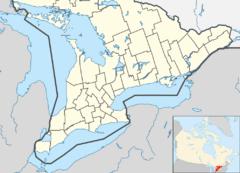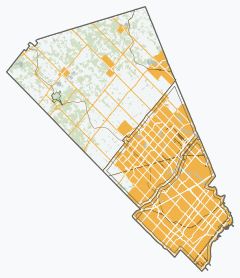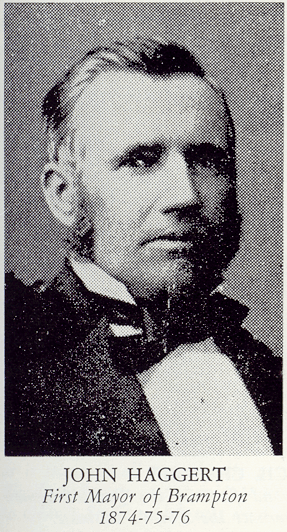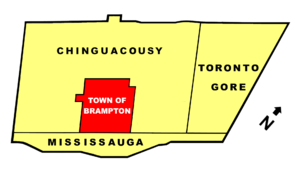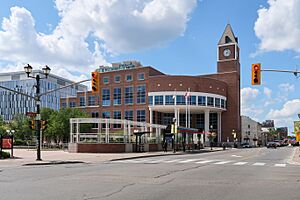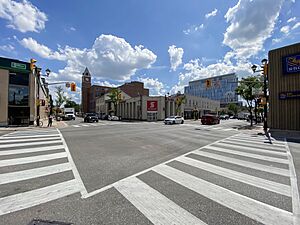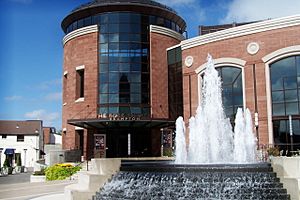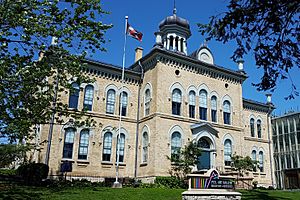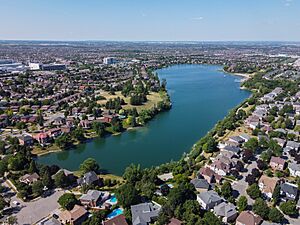Brampton facts for kids
Quick facts for kids
Brampton
|
|||
|---|---|---|---|
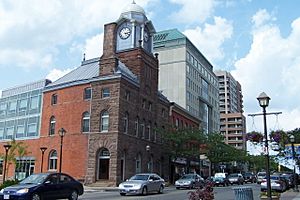
The Brampton Dominion building
|
|||
|
|||
| Nickname(s):
Flower City (previously Flower Town)
|
|||
| Country | Canada | ||
| Province | Ontario | ||
| Region | Peel | ||
| Incorporation | 1853 (village) | ||
| 1873 (town) | |||
| 1974 (city) | |||
| Area
(2021)
|
|||
| • Land | 265.89 km2 (102.66 sq mi) | ||
| Elevation | 218 m (715 ft) | ||
| Population
(2021)
|
|||
| • Total | 656,480 (9th) | ||
| • Density | 2,469.0/km2 (6,395/sq mi) | ||
| Demonym(s) | Bramptonian | ||
| Time zone | UTC−05:00 (EST) | ||
| • Summer (DST) | UTC−04:00 (EDT) | ||
| Forward sortation area |
L6P to L7A
|
||
| Area code(s) | 905, 289, 365, and 742 | ||
Brampton is a large city in the Canadian province of Ontario. It is part of the Greater Toronto Area (GTA) and is the main city in the Peel Region. In 2021, Brampton had a population of 656,480 people. This makes it the ninth most populated city in Canada. It is also the third largest city in the Greater Golden Horseshoe urban area, after Toronto and Mississauga.
Brampton is surrounded by other cities and towns. To the east is Vaughan, to the west is Halton Hills, and to the north is Caledon. Mississauga is to the south, and Etobicoke (part of Toronto) is to the southeast.
The city was named after a town called Brampton in England. It officially became a village in 1853, a town in 1873, and a city in 1974. The modern city of Brampton was created by joining several smaller communities and areas.
Brampton was once known as "The Flower Town of Canada." This was because it had many greenhouses and a big flower-growing industry in the 1860s. Today, it still uses "Flower City" as its slogan.
The city has grown a lot recently. Even though it was built for cars, Brampton has a good public transportation system. Many people in Brampton are of South Asian background, making it a very diverse city.
Contents
History of Brampton
Before British settlers arrived, the Mississaugas of the Credit First Nation lived on a large area of land here. European settlers started coming to the area in the 1600s. In 1818, the chief of the Mississaugas signed a treaty, giving the land to the British Crown.
In the 1830s, a place called "Buffy's Corners" was the main spot for business. By 1834, a man named John Elliott started selling land lots and called the area "Brampton." This name soon became popular.
In 1853, a small agricultural fair began at the corner of Main and Queen streets. Farmers sold grains, produce, and livestock. This fair grew into the modern Brampton Fall Fair. In the same year, Brampton became an official village. In 1866, it became the county seat, meaning it was the main town for the county.
Edward Dale, who came from England in 1863, started a flower nursery in Brampton. Dale's Nursery became the biggest employer in town. It developed a system for grading flowers and sold them all over the world. At its busiest, the company had 140 greenhouses and was the largest cut flower business in North America. This led to many other flower nurseries opening in Brampton.
In 1867, Peel County separated from York County. By 1869, Brampton had 1,800 people. It officially became a town in 1873.
Early Brampton had problems with water supply. In 1878, officials found Heart Lake (then called Snell's Lake) as a good water source. They built a pipeline to bring water to the town. Today, Heart Lake is part of the Heart Lake Conservation Area.
In 1887, Brampton opened its first public library. In 1907, the library received money from Andrew Carnegie to build a new, bigger library. This library is still part of the Brampton Library system today.
In 1902, Sir William James Gage, a publisher, bought land and donated it to the town to create a park. This park is now known as Gage Park.
In 1974, two nearby areas, Chinguacousy and Toronto Gore, joined with Brampton. This made Brampton much larger and included communities like Bramalea and Heart Lake. The small pine tree on the Brampton city flag represents Chinguacousy.
In 1963, the town started The Flower Festival of Brampton. It began to call itself the Flower Town of Canada. In 2002, the city started the "Flower City Strategy" to celebrate its flower-growing past. This plan encourages beautiful landscaping and protects the city's natural and cultural history. The Rose Theatre was named to fit this idea.
The Development of Bramalea
Bramalea was a new community built in the 1960s, just east of Brampton. It was Canada's first "satellite community," meaning it was planned as a self-contained town. The name "Bramalea" combines "BRAM" from Brampton, "MAL" from Malton, and "LEA" (an old English word for meadow).
Bramalea was carefully planned with parks and a "downtown" area. This downtown included the Civic Centre, built in 1972, which had the city hall and library. The Bramalea City Centre shopping mall was also built nearby.
The Region of Peel
In 1974, the Ontario government changed how Peel County was organized. It created the Regional Municipality of Peel. Brampton became the main administrative center for this new region. The regional police, health department, and the Peel Art Gallery, Museum and Archives are all in Brampton.
Some people were not happy about these changes because they liked their local identities. Brampton residents worried their town would lose its unique feel. Bramalea residents were proud of their planned community. However, many now see themselves as part of the larger Brampton area.
Brampton's Growth as a City

In the early 1980s, Brampton bought the Capitol Theatre and turned it into a performing arts center called the Heritage Theatre. Later, the city built a new, modern theatre, the Rose Theatre, which opened in 2006. It has been very successful, bringing many people to downtown Brampton.
In 1982, a festival called Carabram was started by volunteers from different ethnic groups. It celebrates diversity and friendship between cultures. It began with Italian, Scottish, Ukrainian, and West Indian groups.
Brampton has become one of Canada's most diverse cities. In 2016, almost half of the city's population was of South Asian origin. Many people in Brampton were born in other countries. Schools in Brampton offer language programs to help students learn English and their family's ancestral languages.
In the late 1980s, a new city hall was built downtown. It opened in 1991 and brought the city government back to the heart of Brampton. The building was expanded in 2014.
The city continues to grow. New communities like Springdale have been developed. In 2003, Brampton celebrated its 150th anniversary with a big parade and other events.
Cityscape
Geography and Climate
Brampton covers about 265 square kilometers. Its borders are Highway 50 to the east, Winston Churchill Boulevard to the west, and Mayfield Road to the north. To the south, it borders Mississauga.
Climate in Brampton
Brampton has a continental climate, which means it has warm summers and cold winters. This is typical for the Greater Toronto Area.
Data from Toronto Pearson International Airport, located 10.55 km (6.56 mi) east.
| Climate data for Lester B. Pearson International Airport 1981–2010 (Brampton and North Mississauga) | |||||||||||||
|---|---|---|---|---|---|---|---|---|---|---|---|---|---|
| Month | Jan | Feb | Mar | Apr | May | Jun | Jul | Aug | Sep | Oct | Nov | Dec | Year |
| Record high humidex | 19.0 | 14.8 | 29.2 | 37.9 | 42.6 | 45.0 | 50.3 | 46.6 | 48.0 | 39.1 | 28.6 | 23.9 | 50.3 |
| Record high °C (°F) | 17.6 (63.7) |
17.7 (63.9) |
25.6 (78.1) |
31.1 (88.0) |
34.4 (93.9) |
36.7 (98.1) |
37.6 (99.7) |
38.3 (100.9) |
36.7 (98.1) |
31.6 (88.9) |
25.0 (77.0) |
20.0 (68.0) |
38.3 (100.9) |
| Mean daily maximum °C (°F) | −1.5 (29.3) |
−0.4 (31.3) |
4.6 (40.3) |
12.2 (54.0) |
18.8 (65.8) |
24.2 (75.6) |
27.1 (80.8) |
26.0 (78.8) |
21.6 (70.9) |
14.3 (57.7) |
7.6 (45.7) |
1.4 (34.5) |
13.0 (55.4) |
| Daily mean °C (°F) | −5.5 (22.1) |
−4.5 (23.9) |
0.1 (32.2) |
7.1 (44.8) |
13.1 (55.6) |
18.6 (65.5) |
21.5 (70.7) |
20.6 (69.1) |
16.2 (61.2) |
9.5 (49.1) |
3.7 (38.7) |
−2.2 (28.0) |
8.2 (46.8) |
| Mean daily minimum °C (°F) | −9.4 (15.1) |
−8.7 (16.3) |
−4.5 (23.9) |
1.9 (35.4) |
7.4 (45.3) |
13.0 (55.4) |
15.8 (60.4) |
15.1 (59.2) |
10.8 (51.4) |
4.6 (40.3) |
−0.2 (31.6) |
−5.8 (21.6) |
3.3 (37.9) |
| Record low °C (°F) | −31.3 (−24.3) |
−31.1 (−24.0) |
−28.9 (−20.0) |
−17.2 (1.0) |
−5.6 (21.9) |
0.6 (33.1) |
3.9 (39.0) |
1.1 (34.0) |
−3.9 (25.0) |
−8.3 (17.1) |
−18.3 (−0.9) |
−31.1 (−24.0) |
−31.3 (−24.3) |
| Record low wind chill | −44.7 | −38.9 | −36.2 | −25.4 | −9.5 | 0.0 | 0.0 | 0.0 | −8.0 | −13.5 | −25.4 | −38.5 | −44.7 |
| Average precipitation mm (inches) | 51.8 (2.04) |
47.7 (1.88) |
49.8 (1.96) |
68.5 (2.70) |
74.3 (2.93) |
71.5 (2.81) |
75.7 (2.98) |
78.1 (3.07) |
74.5 (2.93) |
61.1 (2.41) |
75.1 (2.96) |
57.9 (2.28) |
785.9 (30.94) |
| Average rainfall mm (inches) | 25.1 (0.99) |
24.3 (0.96) |
32.6 (1.28) |
63.0 (2.48) |
74.3 (2.93) |
71.5 (2.81) |
75.7 (2.98) |
78.1 (3.07) |
74.5 (2.93) |
60.6 (2.39) |
68.0 (2.68) |
34.0 (1.34) |
681.6 (26.83) |
| Average snowfall cm (inches) | 29.5 (11.6) |
24.0 (9.4) |
17.7 (7.0) |
4.5 (1.8) |
0.02 (0.01) |
0.0 (0.0) |
0.0 (0.0) |
0.0 (0.0) |
0.0 (0.0) |
0.4 (0.2) |
7.5 (3.0) |
24.9 (9.8) |
108.5 (42.7) |
| Average precipitation days (≥ 0.2 mm) | 15.1 | 11.6 | 12.4 | 12.5 | 12.5 | 10.8 | 10.4 | 10.2 | 10.5 | 12.1 | 13.2 | 14.8 | 145.9 |
| Average rainy days (≥ 0.2 mm) | 5.4 | 4.6 | 7.4 | 11.3 | 12.5 | 10.8 | 10.4 | 10.2 | 10.5 | 12.0 | 11.0 | 7.1 | 113.2 |
| Average snowy days (≥ 0.2 cm) | 12.1 | 9.4 | 6.8 | 2.4 | 0.03 | 0.0 | 0.0 | 0.0 | 0.0 | 0.3 | 3.4 | 10.0 | 44.4 |
| Average relative humidity (%) | 80.8 | 79.3 | 78.1 | 75.4 | 77.2 | 79.8 | 81.9 | 85.7 | 87.4 | 85.2 | 83.3 | 81.8 | 81.3 |
| Mean monthly sunshine hours | 79.7 | 112.2 | 159.4 | 204.4 | 228.2 | 249.7 | 294.4 | 274.5 | 215.7 | 163.7 | 94.2 | 86.2 | 2,161.4 |
| Percent possible sunshine | 27.6 | 38.0 | 43.2 | 50.8 | 50.1 | 54.1 | 63.0 | 63.4 | 57.4 | 47.8 | 32.0 | 30.9 | 46.5 |
| Source: Environment Canada | |||||||||||||
Data is from Georgetown, located 10.93 km (6.79 mi) south southwest.
| Climate data for Georgetown WWTP (Halton Hills), 1981−2010 | |||||||||||||
|---|---|---|---|---|---|---|---|---|---|---|---|---|---|
| Month | Jan | Feb | Mar | Apr | May | Jun | Jul | Aug | Sep | Oct | Nov | Dec | Year |
| Record high °C (°F) | 17.0 (62.6) |
15.5 (59.9) |
25.0 (77.0) |
31.5 (88.7) |
34.5 (94.1) |
36.0 (96.8) |
37.0 (98.6) |
36.5 (97.7) |
35.5 (95.9) |
29.5 (85.1) |
22.0 (71.6) |
20.5 (68.9) |
37.0 (98.6) |
| Mean daily maximum °C (°F) | −1.7 (28.9) |
−0.2 (31.6) |
4.6 (40.3) |
12.1 (53.8) |
19.1 (66.4) |
24.4 (75.9) |
26.9 (80.4) |
25.8 (78.4) |
21.4 (70.5) |
14.3 (57.7) |
7.3 (45.1) |
1.1 (34.0) |
12.9 (55.2) |
| Daily mean °C (°F) | −6.3 (20.7) |
−5.2 (22.6) |
−0.9 (30.4) |
6.0 (42.8) |
12.3 (54.1) |
17.4 (63.3) |
20.0 (68.0) |
19.0 (66.2) |
14.8 (58.6) |
8.4 (47.1) |
2.8 (37.0) |
−2.9 (26.8) |
7.1 (44.8) |
| Mean daily minimum °C (°F) | −10.9 (12.4) |
−10.2 (13.6) |
−6.4 (20.5) |
−0.2 (31.6) |
5.3 (41.5) |
10.4 (50.7) |
13.0 (55.4) |
12.1 (53.8) |
8.1 (46.6) |
2.4 (36.3) |
−1.7 (28.9) |
−6.9 (19.6) |
1.3 (34.3) |
| Record low °C (°F) | −33.0 (−27.4) |
−31.5 (−24.7) |
−28.0 (−18.4) |
−13.0 (8.6) |
−5.0 (23.0) |
−0.5 (31.1) |
3.0 (37.4) |
0.0 (32.0) |
−4.0 (24.8) |
−8.5 (16.7) |
−15.5 (4.1) |
−29.5 (−21.1) |
−33.0 (−27.4) |
| Average precipitation mm (inches) | 67.8 (2.67) |
60.0 (2.36) |
57.2 (2.25) |
76.5 (3.01) |
79.3 (3.12) |
74.8 (2.94) |
73.5 (2.89) |
79.3 (3.12) |
86.2 (3.39) |
68.3 (2.69) |
88.5 (3.48) |
65.9 (2.59) |
877.4 (34.54) |
| Average rainfall mm (inches) | 29.7 (1.17) |
28.4 (1.12) |
35.2 (1.39) |
71.3 (2.81) |
79.0 (3.11) |
74.8 (2.94) |
73.5 (2.89) |
79.3 (3.12) |
86.2 (3.39) |
67.8 (2.67) |
79.9 (3.15) |
36.4 (1.43) |
741.5 (29.19) |
| Average snowfall cm (inches) | 38.1 (15.0) |
31.7 (12.5) |
22.1 (8.7) |
5.2 (2.0) |
0.3 (0.1) |
0.0 (0.0) |
0.0 (0.0) |
0.0 (0.0) |
0.0 (0.0) |
0.5 (0.2) |
8.6 (3.4) |
29.5 (11.6) |
135.9 (53.5) |
| Average precipitation days (≥ 0.2 mm) | 12.6 | 9.4 | 10.6 | 12.4 | 11.9 | 11.2 | 10.6 | 10.6 | 11.7 | 12.3 | 13.3 | 12.3 | 138.9 |
| Average rainy days (≥ 0.2 mm) | 4.1 | 4.1 | 6.4 | 11.6 | 11.8 | 11.2 | 10.6 | 10.6 | 11.7 | 12.2 | 11.4 | 6.5 | 112.1 |
| Average snowy days (≥ 0.2 cm) | 9.4 | 6.2 | 4.8 | 1.4 | 0.04 | 0.0 | 0.0 | 0.0 | 0.0 | 0.27 | 2.5 | 6.9 | 31.5 |
| Source: Environment Canada | |||||||||||||
People and Cultures
| Historical populations | ||
|---|---|---|
| Year | Pop. | ±% |
| 1858 | 50 | — |
| 1871 | 2,090 | +4080.0% |
| 1881 | 2,920 | +39.7% |
| 1891 | 3,252 | +11.4% |
| 1901 | 2,748 | −15.5% |
| 1911 | 3,412 | +24.2% |
| 1921 | 4,527 | +32.7% |
| 1931 | 5,532 | +22.2% |
| 1941 | 5,975 | +8.0% |
| 1951 | 8,389 | +40.4% |
| 1961 | 18,467 | +120.1% |
| 1971 | 41,211 | +123.2% |
| 1981 | 149,030 | +261.6% |
| 1991 | 234,445 | +57.3% |
| 1996 | 268,251 | +14.4% |
| 2001 | 325,428 | +21.3% |
| 2006 | 433,806 | +33.3% |
| 2011 | 523,906 | +20.8% |
| 2016 | 593,638 | +13.3% |
| 2021 | 656,480 | +10.6% |
| Brampton annexed Chinguacousy—which included the highly populated community of Bramalea—and Toronto Gore Townships in 1974. The 2011 population count was revised in 2016. |
||
In the 2021 Canadian census, Brampton's population was 656,480. This was a 10.6% increase from 2016, making Brampton one of Canada's fastest-growing large cities.
Ethnic Backgrounds
In 2021, the largest ethnic group in Brampton was people of South Asian origin, making up 52.4% of the population. Other groups include those of European (18.9%), Black (13.1%), and Filipino (3.2%) backgrounds. About 60% of Brampton's residents were born outside of Canada.
| Group | 2021 | 2016 | 2011 | 2006 | 2001 | 1996 | ||||||||
|---|---|---|---|---|---|---|---|---|---|---|---|---|---|---|
| Pop. | % | Pop. | % | Pop. | % | Pop. | % | Pop. | % | Pop. | % | |||
| South Asian | 340,815 | 52.42% | 261,705 | 44.29% | 200,220 | 38.41% | 136,750 | 31.69% | 63,205 | 19.48% | 34,720 | 13% | ||
| European | 123,060 | 18.93% | 153,390 | 25.96% | 171,655 | 32.93% | 182,760 | 42.35% | 192,395 | 59.31% | 186,270 | 69.72% | ||
| Black | 85,310 | 13.12% | 82,175 | 13.91% | 70,290 | 13.48% | 53,340 | 12.36% | 32,070 | 9.89% | 21,810 | 8.16% | ||
| Southeast Asian | 30,155 | 4.64% | 28,525 | 4.83% | 26,535 | 5.09% | 18,110 | 4.2% | 9,970 | 3.07% | 6,990 | 2.62% | ||
| Middle Eastern | 13,715 | 2.11% | 11,320 | 1.92% | 7,610 | 1.46% | 5,475 | 1.27% | 2,935 | 0.9% | 1,995 | 0.75% | ||
| Latin American | 13,490 | 2.07% | 14,045 | 2.38% | 11,405 | 2.19% | 8,545 | 1.98% | 5,225 | 1.61% | 2,595 | 0.97% | ||
| East Asian | 8,000 | 1.23% | 9,915 | 1.68% | 9,235 | 1.77% | 8,930 | 2.07% | 6,595 | 2.03% | 6,100 | 2.28% | ||
| Indigenous | 3,255 | 0.5% | 4,330 | 0.73% | 3,430 | 0.66% | 2,665 | 0.62% | 1,720 | 0.53% | 950 | 0.36% | ||
| Other/Multiracial | 32,370 | 4.98% | 25,535 | 4.32% | 20,940 | 4.02% | 14,995 | 3.47% | 10,290 | 3.17% | 5,740 | 2.15% | ||
| Total responses | 650,165 | 99.04% | 590,950 | 99.55% | 521,315 | 99.5% | 431,575 | 99.49% | 324,390 | 99.68% | 267,170 | 99.6% | ||
| Total population | 656,480 | 100% | 593,638 | 100% | 523,911 | 100% | 433,806 | 100% | 325,428 | 100% | 268,251 | 100% | ||
| Note: Totals greater than 100% due to multiple origin responses | ||||||||||||||
Religion in Brampton (2021) Christianity (35.7%) Sikhism (25.1%) Hinduism (18.1%) No Religion (10.3%) Islam (9.1%) Buddhism (1.1%) Judaism (0.1%) Indigenous (0.0%) Other Religions (0.4%)
Religions in Brampton
In 2021, the most common religion in Brampton was Christianity (35.7%). This includes Catholicism as the largest Christian group. Other major religions are Sikhism (25.1%), Hinduism (18.1%), and Islam (9.1%). About 10.3% of the population did not identify with a specific religion. Brampton has Canada's largest Sikh population and the second-largest Hindu population.
| Religious group |
2021 | 2011 | 2001 | 1991 | ||||
|---|---|---|---|---|---|---|---|---|
| Pop. | % | Pop. | % | Pop. | % | Pop. | % | |
| 232,220 | 35.72% | 263,385 | 50.52% | 219,880 | 67.78% | 185,780 | 79.58% | |
| 163,260 | 25.11% | 97,790 | 18.76% | 34,510 | 10.64% | 8,630 | 3.7% | |
| 117,395 | 18.06% | 63,390 | 12.16% | 17,640 | 5.44% | 6,415 | 2.75% | |
| 59,445 | 9.14% | 36,960 | 7.09% | 11,470 | 3.54% | 4,660 | 2% | |
| 7,105 | 1.09% | 6,715 | 1.29% | 3,340 | 1.03% | 1,290 | 0.55% | |
| 535 | 0.08% | 830 | 0.16% | 610 | 0.19% | 805 | 0.34% | |
| Other religion | 2,940 | 0.45% | 1,340 | 0.26% | 930 | 0.29% | 440 | 0.19% |
| No Religion | 67,265 | 10.35% | 50,885 | 9.76% | 36,010 | 11.1% | 25,435 | 10.89% |
| Total responses | 650,165 | 99.04% | 521,315 | 99.5% | 324,390 | 99.68% | 233,460 | 99.58% |
Languages Spoken
In 2021, English was the main language spoken at home for 42.9% of Brampton's population. Other common languages include Punjabi (21.7%), Gujarati (3.4%), and Urdu (3.4%). Most people in Brampton know English (95.1%) and Punjabi (29.1%).
| Main Language | Population | % |
|---|---|---|
| English | 279,415 | 42.9 |
| Punjabi | 141,005 | 21.7 |
| Gujarati | 22,000 | 3.4 |
| Urdu | 21,945 | 3.4 |
| Hindi | 19,645 | 3 |
| Tamil | 14,030 | 2.2 |
| Spanish | 10,185 | 1.6 |
| Tagalog (Filipino) | 9,905 | 1.5 |
| Portuguese | 8,640 | 1.3 |
| Italian | 5,430 | 0.8 |
| Vietnamese | 4,230 | 0.6 |
| Arabic | 4,100 | 0.6 |
| Malayalam | 3,930 | 0.6 |
| French | 3,810 | 0.6 |
| Polish | 3,430 | 0.5 |
| Bengali | 3,060 | 0.5 |
| Telugu | 2,920 | 0.4 |
| Yue (Cantonese) | 2,775 | 0.4 |
| Akan (Twi) | 2,530 | 0.4 |
| Dari | 2,305 | 0.4 |
| Mandarin | 2,195 | 0.3 |
| Nepali | 1,945 | 0.3 |
| Assyrian Neo-Aramaic | 1,940 | 0.3 |
| Sinhala (Sinhalese) | 1,555 | 0.2 |
| Serbo-Croatian | 1,385 | 0.2 |
| Known Languages | Population | % |
|---|---|---|
| English | 618,060 | 95.1 |
| Punjabi | 189,235 | 29.1 |
| Hindi | 113,515 | 17.5 |
| Urdu | 38,725 | 6 |
| Gujarati | 30,310 | 4.7 |
| French | 30,010 | 4.6 |
| Tamil | 21,475 | 3.3 |
| Spanish | 15,395 | 2.4 |
| Tagalog (Filipino) | 14,925 | 2.3 |
| Portuguese | 11,765 | 1.8 |
| Italian | 8,905 | 1.4 |
| Arabic | 8,475 | 1.3 |
| Malayalam | 6,090 | 0.9 |
| Vietnamese | 6,030 | 0.9 |
| Telugu | 5,540 | 0.9 |
| Bengali | 5,080 | 0.8 |
| Akan (Twi) | 4,555 | 0.7 |
| Polish | 4,150 | 0.6 |
| Yue (Cantonese) | 3,680 | 0.6 |
| Mandarin | 3,660 | 0.6 |
| Dari | 3,350 | 0.5 |
| Marathi | 3,185 | 0.5 |
| Yoruba | 3,050 | 0.5 |
| Sinhala (Sinhalese) | 2,540 | 0.4 |
| Assyrian Neo-Aramaic | 2,440 | 0.4 |
Economy and Businesses
Many important companies have their main offices or large facilities in Brampton. These include MDA Space Missions, which builds parts for space missions like CanadaArm 3. Other big names are Loblaw Companies Ltd., Gamma-Dynacare Medical Laboratories, Mandarin Restaurant, Brita, and Clorox.
Major companies with operations in Brampton include CN Rail, Best Buy, Amazon (with four facilities), Ford, Nestlé, Hudson's Bay Company (HBC), Frito Lay Canada, and Coca-Cola.
Alstom has a factory in Brampton that builds light rail vehicles (LRVs) for transit lines in the Greater Toronto Area. The city is also home to a Canadian Forces Army Reserve unit.
An automobile factory, now called Brampton Assembly, is one of the city's largest employers. It was originally opened by American Motors in 1960.
Education in Brampton
Brampton offers various educational opportunities. Algoma University at Brampton has a School of Business & Economics. Nearby universities like York University and University of Toronto Mississauga offer more programs.
Sheridan College's Davis Campus is a major college in Brampton. It has a Skilled Trades Centre for training in various trades. In 2022, Toronto Metropolitan University announced plans to open a medical school in Brampton. The city council gave the university the former Bramalea Civic Centre for this purpose.
Brampton also has many private colleges that offer job training.
Two main public school boards serve Brampton:
- The Peel District School Board runs public English-speaking schools. It has 16 high schools and 85 elementary and middle schools.
- The Dufferin-Peel Catholic District School Board runs Catholic English-speaking schools. It has 9 high schools and 44 elementary and middle schools.
There are also French-speaking public and Catholic schools in the area.
Culture and Arts
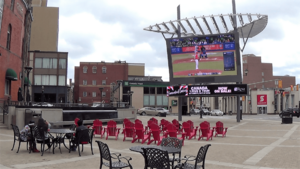
The Brampton Arts Council supports many cultural groups in the city. The Peel Art Gallery, Museum and Archives (PAMA) is run by the Peel Region. It has a museum, art gallery, and archives.
The Rose Theatre opened in 2006 and is a popular place for performing arts. It has brought many new visitors and businesses to downtown Brampton. A new Fountain Stage was added at the nearby Garden Square in 2008.
Brampton has eight library branches. The city also hosts the annual Festival of Literary Diversity, which celebrates writers from diverse backgrounds.
PAMA shows art from local, national, and international artists. Brampton's efforts to preserve its history have won awards.
Fun Places to Visit
- Gage Park: A beautiful park with an outdoor ice path for skating in winter.
- CAA Centre: A large sports and entertainment venue.
- Chinguacousy Park-Greenhouse and gardens: A big park with a greenhouse, gardens, and even a small ski hill.
- Claireville Conservation Area and Heart Lake Conservation Area: Great places for nature and outdoor activities.
- Historic Bovaird House: A historic house that shows what life was like long ago.
- Peel Art Gallery, Museum and Archives: Learn about art, history, and local records.
- Professor's Lake: A lake where people can enjoy the beach.
- Rose Theatre: A modern theatre for live performances.
- Wet'n'Wild Toronto: A water park for summer fun.
Major shopping areas include Bramalea City Centre, Shoppers World, and Trinity Commons.
Media in Brampton
The Brampton Guardian is the city's main newspaper. Brampton also has community TV channels. Two radio stations, CHLO and CFNY, are officially based in Brampton, but their programs reach the whole Greater Toronto Area.
Sports and Recreation
| Team | League | Sport | Venue | Established | Disestablished | Championships |
|---|---|---|---|---|---|---|
|
Brampton Honey Badgers |
Canadian Elite Basketball League | Basketball | CAA Centre | 2019* | 1 | |
| Brampton A's | National Basketball League of Canada | Basketball | Powerade Centre | 2013 | 2015 | 0 |
| Brampton Admirals | Ontario Junior Hockey League | Hockey | Brampton Memorial Arena | 2018 | 2021 | 0 |
| Brampton Battalion | OHL | Hockey | Powerade Centre | 1998 | 2013 | 0 |
| Brampton Beast | ECHL | Hockey | CAA Centre | 2013 | 2021 | 0 |
| Bramalea Blues | Ontario Provincial Junior A Hockey League | Hockey | Powerade Centre | 1972 | 2010 | 1 |
| Brampton Bombers | Greater Ontario Junior Hockey League | Hockey | Brampton Memorial Arena | 2012 | 2020 | 0 |
| Brampton Thunder | Canadian Women's Hockey League | Hockey | Powerade Centre | 1999 | 2017 | 0 |
| Brampton Capitals | Ontario Provincial Junior A Hockey League | Hockey | Brampton Memorial Arena | 1984 | 2012 | 4 |
| Brampton Excelsiors | Major Series Lacrosse Senior "A" Lacrosse League. | Box Lacrosse | CAA Centre | 1912 | 30 | |
| Junior Excelsiors | OLA Junior A Lacrosse League | Box Lacrosse | Brampton Memorial Arena | 1971 | 4 | |
| Junior "b" Excelsiors | OLA Junior B Lacrosse League | Box Lacrosse | Victoria Park Arena | 2012 | 0 | |
| Bramalea Satellites | Northern Football Conference | Football | 1974 | 1975 | ||
| Brampton City United FC | Canadian Soccer League, First Division | Soccer | Victoria Park Stadium | 2002 | 2016 | 1 |
| Brampton Wolves | Global T20 Canada | Cricket | CAA Centre | 2019 | 1 | |
|
Brampton Steelheads |
Ontario Hockey League | Ice Hockey | CAA Centre | 1996* | 0 |
- The Honey Badgers relocated from Hamilton for the 2023 season.
- The Steelheads relocated from Mississauga for the 2024–25 season.
Brampton has been home to several sports teams. The CAA Centre is a major sports venue. You can enjoy outdoor ice skating at Gage Park. Chinguacousy Park has a ski lift, a curling club, and a Tennis Centre. In summer, many amateur softball leagues play.
Brampton has also hosted major sports events, including the 2013 Junior Women's Softball World Championship and the 2023 IIHF Women's World Championship.
City Services
Health and Hospitals
William Osler Health System runs two health facilities in Brampton.
Courts and Justice
The A. Grenville and William Davis Courthouse is located in Brampton. It handles cases for the Ontario Court of Justice and the Ontario Superior Court of Justice.
Transportation in Brampton
Public Transportation
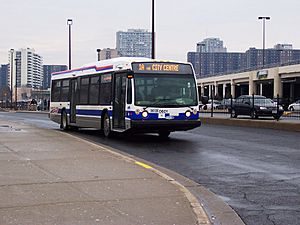
Brampton Transit provides local bus service throughout the city. You can also connect to other transit systems like MiWay (Mississauga) and York Region Transit. Brampton Transit also has a special bus rapid transit system called "Züm" (pronounced Zoom).
GO Transit offers bus and train services. There are three GO Train stations in Brampton along the Kitchener line: Bramalea, Brampton, and Mount Pleasant. These trains connect Brampton to Toronto. Via Rail also has train service through Brampton.
Air Travel
Canada's busiest airport, Toronto Pearson International Airport, is located nearby in Mississauga. For smaller planes, the privately owned Brampton Airport is just north of the city in Caledon.
Roads and Highways
Brampton is served by several major roads. Highway 410 runs north-south through the city. Highway 407 runs along the southern part of the city. Important east-west streets include Steeles Avenue and Queen Street. Main Street is a key north-south road. Airport Road is a busy road in the east end.
Brampton in Media
- The 2008 film Heaven on Earth is set in Brampton.
Famous People from Brampton
Many notable people have connections to Brampton.
Leaders and Politicians
Three Canadian premiers started their careers in Brampton: Tobias Norris and Howard Pawley (from Manitoba), and William Grenville Davis (from Ontario). Other important politicians include John Coyne and Gordon Graydon.
Jagmeet Singh began his political journey in Brampton. He became the leader of the federal NDP in 2017. He was the first person from a visible minority group to become a permanent leader of a major federal party in Canada.
Sports Stars
Brampton has produced many talented athletes across different sports:
- Baseball: Zach Pop
- Basketball: Tyler Ennis, Tristan Thompson, Anthony Bennett
- Cricket: Saad Bin Zafar, Cecil Pervez
- Curling: Wayne Middaugh, Allison Pottinger
- Football: Jerome Messam, Jamaal Westerman
- Golf: David Hearn
- Hockey: Rick Nash, Tyler Seguin, Cassie Campbell, Sean Monahan, Scott Wedgewood
- Lacrosse: Jim Veltman
- Soccer: Atiba Hutchinson, Doneil Henry, Junior Hoilett, Paul Stalteri, Cyle Larin, Tajon Buchanan, Liam Millar
- Tennis: Milos Raonic
Artists and Entertainers
- Authors: Rohinton Mistry, Jesse Thistle, Rupi Kaur (poet).
- Visual Artists: Caroline Helena Armington, Ronald Bloore, Jack Reid.
- Musicians: Punk band The Flatliners, Indie Rock band Moneen, R&B singer Keshia Chanté, country singer Johnny Reid, pop singer Alyssa Reid, Lee Aaron, Alessia Cara, hip-hop artists Roy Woods and Tory Lanez, and record producer WondaGurl.
- Comedians: Scott Thompson and Russell Peters.
- Actors: Michael Cera, twin actors Shawn Ashmore and Aaron Ashmore, Tyler Labine, Paulo Costanzo, Jordan Gavaris, Kris Lemche, Lara Jean Chorostecki.
Sister Cities
Brampton has special relationships with cities around the world:
- Miami Beach, Florida, USA
- Plano, Texas, USA
It also has friendship relationships with:
- Ribeira Grande, Portugal
- Xuzhou, Jiangsu, China
- Brampton, Westmorland and Furness, Cumbria, England
- Marikina, Philippines
- Gapyeong, South Korea
- Fangshan District (Funhill), Beijing, China
See also
 In Spanish: Brampton (Ontario) para niños
In Spanish: Brampton (Ontario) para niños
- Brampton Board of Trade
- Downtown Brampton
- List of historic places in Brampton



